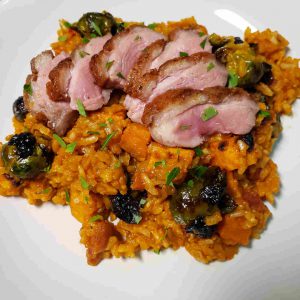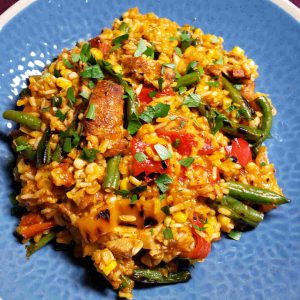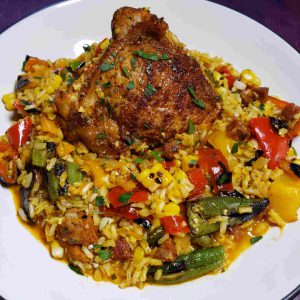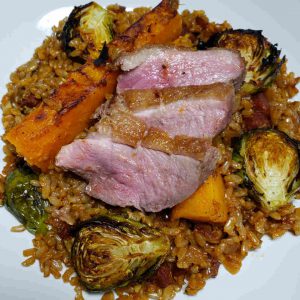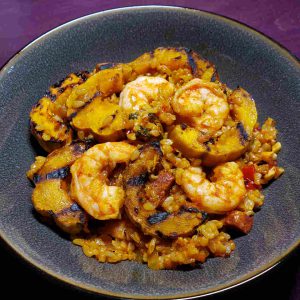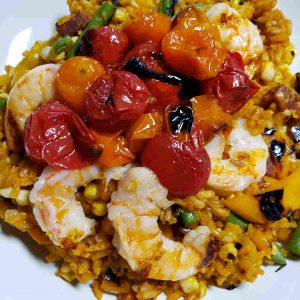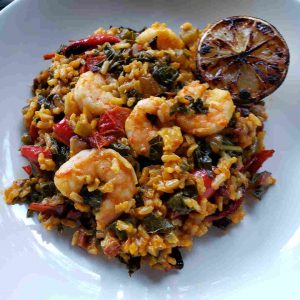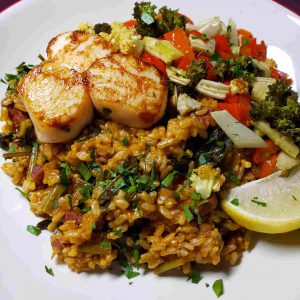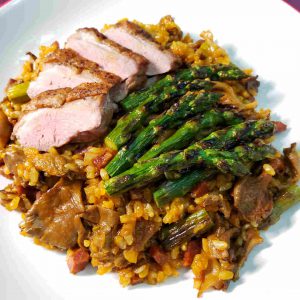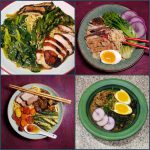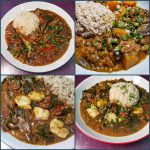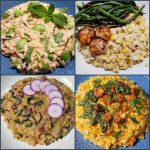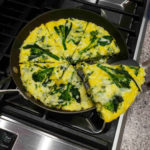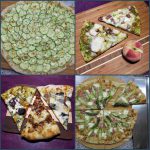Gallery
Gallery depicting several potential combinations of ingredients that can be used with this mother dish technique.
If you haven’t read it yet, I recommend reading my About Paella post before digging into my paella mother dish technique.
The Elements
Spanish Chorizo
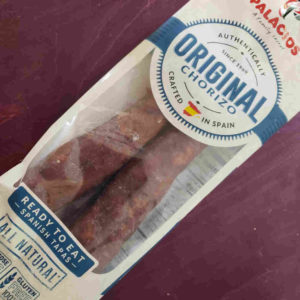
Straight off the top, I use this controversial ingredient. Using Spanish chorizo is pretty common for paella recipes in the US, but as noted in the About Paella post, some would vehemently declare that there should be no chorizo in paella. I start my paella by rendering the fats from finely diced Spanish chorizo, so the delectable flavors permeate the dish. Know that Spanish chorizo is very different from Mexican chorizo. Spanish chorizo is an aged dry sausage which is shelf stable when in its casing and looks like pepperoni. Mexican chorizo, also delicious in other applications, is a fresh sausage requiring refrigeration. I usually find Spanish chorizo in 6-8 oz links, and use half a link per recipe.
Short Grain Brown Rice
Again, this is not a traditional ingredient. Paella is, first and foremost, a rice dish. Traditionally it is made with white Spanish Bomba rice, a rounded medium grain rice which holds its firmness when cooked. I prefer brown rice for the whole grain nutrition. I also think it works well here because of the firmness which it maintains. The cooking process must be modified as brown rice takes more liquid and more time to cook. If treated properly, the result is nice.
Sofrito
Like so many cuisines, many Spanish dishes start with a sauté of aromatics. Spanish cuisine refers to this sauté as sofrito. Traditionally, the sofrito will contain onion, garlic, sweet peppers, and tomatoes. For my paella, I always use onion and garlic. I use fresh tomato when in season, or a big dab of tubed tomato paste when they are not. I use peppers when they are in season, sometimes in the sofrito, sometimes as a vegetable in the final dish, and sometimes in both.
Seasonings
My seasoning list is short – smoked paprika, saffron, and salt. Smoked paprika is another controversial ingredient. Perusal of the Paella Wiki shows no paprika (or pimento as it may be labeled) in the traditional recipes. To me, smoked paprika says “Spain” more than any other single seasoning. It also brings the “over an open fire” smokiness to a dish cooked indoors. I also found it to be used in many of the recipes in Alberto Herraiz’s book Paella. Saffron is definitely a core seasoning of traditional paella. Saffron is a very expensive ingredient. In fact, by weight, it is the most expensive seasoning on the planet. The fact that saffron is a core seasoning may be why smoked paprika and Spanish chorizo (which itself is heavily seasoned with paprika) are shunned. They may bully the relatively more delicate saffron flavor. You should experiment with the ratios of these two seasonings to find out which balance you prefer.
Vegetables
Paellas are often protein dominant, incorporating several proteins into one dish with protein expected in every bite. I tone this down, so paella can be a balanced one dish meal. This is not a sacrifice. So many vegetables work with this dish’s flavor profile. I can make wonderful variations throughout the year, with each variation celebrating the current season. In the winter, I might use brussels sprouts and parsnips. In the spring I might use asparagus and fava beans. In the summer I might use corn, green beans and sweet peppers. In the fall I might use butternut squash and mushrooms.
Proteins
Like the vegetables, many proteins lend themselves well to this dish. There’s a bit of Spanish Chorizo already in the base dish, so I generally keep it to a single protein. The first decision is surf or turf. On the surf side I tend to use either shrimp or scallops. On the turf side, I go with duck or chicken. When it’s chicken, definitely the more flavorful thighs are preferred. Nothing is fixed in stone. I’ve used merguez sausage to great effect.
Stock
Paella is a dish where a really good stock can shine. A popular paella variant is “a banda.” A banda means “next to” in Spanish. For this style, seafoods are used to make a rich stock, and those seafoods are served separately while the “a banda” rice is prepared. Imagine a paella without the integrated proteins, but with all the flavors of those proteins provided by the stock. I do make some stock at home, storing by the quart in the freezer. But I use A LOT more stock than I make. I only use the homemade good stuff when the dish warrants an outstanding stock. Paella is such a dish. If you don’t make your own stock at home, don’t let that stop you from making paella. Just know that if you do occasionally make your own stock, paella is a dish where you might want to use it. Use a stock that matches the protein selection.
The Pan
Again, far from traditional, I use an enameled cast iron braising pan. Thick cast iron would be terrible for paella cooked in the traditional way, but it works well for the stove top and oven method that I employ. I have made this in a standard Lodge Dutch oven and it works well enough. But I prefer a braising pan for its shallow build and flat bottom. The one I use is by Tramontina.
The Method
The method is detailed in the recipe below.
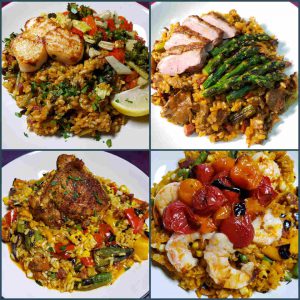
Paella Mother Dish Technique
Equipment
- Enameled cast iron braiser, or enameled cast iron Dutch oven
Ingredients
- 3-4 oz. Spanish chorizo casing removed & chopped to a small dice
- 1 Tbsp olive oil
- 1 medium onion (6-8 oz) finely chopped
- 1 tsp salt
- 3 big garlic cloves minced
- 2 Tbsp tomato paste
- 2 tsp smoked paprika
- 20 saffron threads crumbled,
- 1.5 cups short grain brown rice
- 2 oz dry white wine
- 4 cups GOOD broth
- Cook-ins, tuck-ins and toppings
Instructions
- Preheat oven to 375 degrees Fahrenheit.
- Place an enameled cast iron braiser on the stovetop at medium-high heat. Sauté chorizo in olive oil to render the fat from the sausage.
- Add the diced onion with ½ teaspoon of salt and stir. If there isn’t enough oil to make the onions glisten, add another splash. Sauté until the onions are softened and translucent.
- Stir in the garlic, then make a well and add tomato paste to the center of the well. After a minute or two, stir together the aromatic mixture.
- Add the rice and coat it well with the aromatic mixture. Stir in the saffron, paprika and 1/2 teaspoon of salt.
- Add the dry white wine and use a wooden spatula to deglaze any fond that developed during the previous steps.
- Add the broth and stir. Also add any cook-in ingredients (see notes). Turn the heat up to high, and bring to a boil.
- Cover the pot and place in the oven. Cook for 50 minutes adding tuck-in ingredients (see notes) at appropriate times.
- Remove from the oven. Optionally develop a socarrat (see notes) by placing the uncovered braising pan over medium-high heat for 5 minutes. Either add any top-on ingredients (see notes) to the top of the paella and serve from the pan, or plate portions and add any top-on ingredients directly to the plate.
Notes
- While the rice mixture cooks for 60 minutes, other ingredients may be added over time. The idea is to add things at time intervals that are appropriate for their required cooking times.
- Things that can stand up to a full 60 minutes of poaching alongside the rice are cook-ins. They are added before the pot is brought to a boil.
- Tuck-ins are added later in the process. Note, I am calling them tuck-ins and not mix-ins. Traditionally, once the rice is added, paella is not stirred. Additional ingredients get tucked into the cooking rice. But, if you choose to mix things in, I won’t tell. I do it sometimes myself. Tuck-ins are added at times that are appropriate for their nature. For example, chicken may be added with 30 minutes remaining, but shrimp should only go in with about 6-8 minutes of time remaining.
- Be aware that adding large amounts of refrigerated or room temperature tuck-ins will reduce the temperature of the pot as a whole. Cooking times may have to be adjusted.
- Toppings are things that are cooked separately and added to the top of the paella as it comes out of the oven, or on top of the plated paella. Toppings are cooked separately to add characteristics that go nicely with the paella that would not be achieved by cooking in the pot with the rice. For example, scallops will cook just fine as a tuck-in with 6-8 minutes remaining in the cook time. But, pan searing the scallops separately adds a welcome new dimension to the the dish. I often step out to the gas grill for a few minutes to get a nice smokey char on an ingredient added topping.
- And, sometimes tuck-ins can get some separate attention as well. For example, what I do with chicken thighs. First they get a good seasoning. Next they get their skin browned in the braiser pan before the chorizo is added. Once they’re browned up, they are removed, and the rendered schmaltz stays in the pan add a depth of flavor to the entire dish. The browned chicken gets tucked in, skin side up, with 30 minutes remaining in the cooking process.
- A traditionally cooked paella will have a socarrat which is a layer of crispy, caramelized rice at the bottom of the pan. Many think it’s the best part of the dish. The socarrat develops in a traditionally cooked paella because the rice doesn’t get stirred and the open top pan over an open flame allows the humidity to escape. Optionally, a socarrat can be developed here after removing from the oven, by removing the top of the braising pan and putting over a medium-high burner for 5-10 minutes.
- Garnishes: If the paella uses a seafood based broth, lemon slices make a nice garnish. Parsley is always a winner given the base flavor profile of chorizo, paprika, and saffron.

